
Wrongful Termination Examples: What Constitutes Illegal Firing?
Getting fired can be a nightmare scenario. Besides the financial stress of losing your income, it can also take a serious toll on your self-esteem.
But did you know there are situations when getting terminated is actually against the law? If your employer fires you for an illegal reason, you may have grounds to fight back.
Keep reading as we break down what constitutes unlawful firing with real-world examples of wrongful termination cases. We’ll also explain the steps to take if you suspect you were illegally fired.
What is Considered Wrongful Termination in Florida?
Florida is an at-will employment state, which means employers can generally terminate employees for any reason or no reason at all, provided it does not violate state or federal law. However, there are important exceptions. It is unlawful for an employer to fire an employee based on:
- Race, color, national origin, or ancestry
- Gender or sex
- Pregnancy or maternity leave
- Age (over 40)
- Disability or medical condition
- Religion
- Marital status
- Retaliation for exercising rights under state or federal law
- Breach of employment contract
Terminating an employee for any of these discriminatory reasons violates state and federal laws, such as Title VII of the Civil Rights Act, the Americans with Disabilities Act (ADA), the Age Discrimination in Employment Act (ADEA), and the Florida Civil Rights Act. This constitutes wrongful termination.
In addition, if an employer fires an employee for reporting illegal activity (whistleblowing), requesting medical leave, refusing to commit an illegal act, or exercising other employment rights, this can amount to wrongful termination.
Examples of Wrongful Termination in Florida
While every situation is unique, some common examples of wrongful termination in Florida include:
Discrimination
One of the top reasons employees are wrongfully terminated is discrimination based on a protected characteristic. This includes being fired due to race, gender, age over 40, disability, national origin, or religion.
For example, an employee may be able to show they were fired based on their race through discriminatory comments made by managers or disparate treatment compared to employees of other races. If they can link their termination to racial discrimination, they likely have a wrongful termination claim.
Other examples include firing a female employee after disclosing a pregnancy or terminating an employee shortly after they requested a disability accommodation.
Retaliation
If an employer fires an employee for exercising their employment rights, such as taking medical leave, reporting workplace discrimination, or requesting reasonable accommodations for a disability, this constitutes illegal retaliation.
For example, if an employee files a complaint of sexual harassment by a supervisor and is then terminated a week later, they may have a wrongful termination claim based on retaliation.
Whistleblowing
It is illegal for employers to fire employees for reporting illegal activity, safety violations, or other misconduct. These wrongful termination cases fall under whistleblower protection laws.
For instance, if an employee is fired after reporting safety concerns to OSHA about their employer violating safety regulations, they likely have a wrongful termination claim under whistleblower protection laws.
Breach of Employment Contract
If an employee has an employment contract or collective bargaining agreement stating they can only be fired for “just cause,” firing them without just cause is a breach of contract and wrongful termination.
Violation of Public Policy
Some terminations may be wrongful because they violate an important public policy, even if they do not fall into one of the categories above. For example, firing an employee for serving on jury duty or refusing to break the law at a supervisor’s request.
Real-Life Examples of Wrongful Termination Example
Looking at real-world examples can help illustrate when termination may be illegal and give rise to a wrongful termination claim. Here are a few notable cases:
- Ortiz v. Chipotle: A former Chipotle manager was awarded approximately $8 million after being wrongfully terminated. The case, which initially appeared to revolve around the theft of $636, actually involved issues related to workers’ compensation, FMLA leave, and workplace discrimination.
- EEOC v. Radio Shack: David Nelson, an employee of Radio Shack in Denver for 25 years, faced age discrimination and wrongful termination after getting a new supervisor the year he turned 55.
- Ex-Twitter security executive’s lawsuit: A former Twitter security chief filed a lawsuit alleging wrongful termination after objecting to various cost-cutting measures that he believed posed a substantial danger to public safety.
- Shannon Phillips v. Starbucks: A New Jersey federal judge ordered Starbucks to pay an additional $2.7 million to a former employee who claimed she was fired for being white, on top of a previous $25.6 million awarded in a wrongful termination suit.
- Kavita Lefebvre v. Gisborne Holdings Ltd.: A B.C. woman was awarded $81,100 in compensation for wrongful dismissal after being fired over a “strongly worded” email that the court did not find to be egregious misconduct
How to File a Wrongful Termination Lawsuit in Florida
If you believe you have a wrongful termination claim in Florida, here is an overview of the process for pursuing a lawsuit:
- Consult with a wrongful termination lawyer. They can analyze the facts and advise if grounds exist to challenge the firing. If you have a valid case, they will explain your options to seek damages, get your job back, or both.
- File official complaints with state and federal agencies charged with enforcing employment laws. For discrimination, contact the Florida Commission on Human Relations. Retaliation matters often warrant notifying the Department of Labor or whistleblower protection groups. These paperwork trails bolster wrongful termination demands.
- Gather documentation evidence regarding the termination. Ensure you get copies of your personnel file, including reviews, reprimands, communications related to leave or complaints, and the notice/reasoning behind letting you go. Build a timeline of telling events. Any proof of discriminatory behavior, retaliation, or related misconduct will prove invaluable.
The experienced attorneys at BT Law Group in Miami fight for employees who have been wrongfully terminated in Florida. They handle cases involving discrimination, retaliation, whistleblowing, contract violations, and other wrongful firing scenarios.
If you believe your termination was illegal, contact their team today to explore your options.


